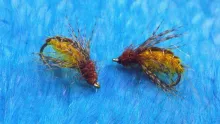In this fly tying tutorial, I showcase the stage prior to a caddisfly becoming an adult, the pupal stage. This fly, TC's Caddis Pupa, has various materials representing the major characteristics of a caddis pupa, and I encourage you to try others to fool trout and grayling in your area. I also feature a special method of utilizing cdc as legs, which is by incorporating the use of a dubbing loop (though I recommend this method for more intermediate tyers).
Featured in this fly tying tutorial are the N205BL hooks by Allen Fly Fishing, which are a thin wire and offset. The hooks are perfect for representing both the larva and pupa stages of the caddis, plus many other insects. Feel free to view these hooks at the following link: http://www.allenflyfishing.com/n205bl-caddis-pupa-and-larva-offset-poin…
Thanks for viewing this fly tying tutorial; feel free to leave any comments on this YouTube page or email me: tcammisa@gmail.com
- Log in to post comments







